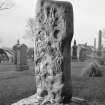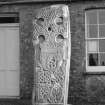Kilmorie, Chapel
Chapel (16th Century) - (19th Century) (1821), Chapel (Medieval) - (16th Century), Cross Slab (Early Medieval), Holy Well (Medieval)
Site Name Kilmorie, Chapel
Classification Chapel (16th Century) - (19th Century) (1821), Chapel (Medieval) - (16th Century), Cross Slab (Early Medieval), Holy Well (Medieval)
Alternative Name(s) St Mary's Well; Corsewall House
Canmore ID 60746
Site Number NX06NW 7
NGR NX 0339 6583
NGR Description NX 0339 6583 and NX 0328 6578
Datum OSGB36 - NGR
Permalink http://canmore.org.uk/site/60746
- Council Dumfries And Galloway
- Parish Kirkcolm
- Former Region Dumfries And Galloway
- Former District Wigtown
- Former County Wigtownshire
Kirkcolm (Kilmorie), Wigtownshire, cross-slab
Measurements: H I.70+, W 0.58m tapering to 0.48m, D 0.24m
Stone type: greywacke
Place of discovery: NX 0339 6583
Evidence for discovery: known at Kilmorie Chapel prior to 1719, when it was taken to Kirkcolm and used as a lintel in the restored church (NX 0306 6885). Kirkcolm church was dismantled in 1821, and the stone was first left in the kirkyard and later taken to the garden of Corsewall House (NSA 1845, 111). In 1987 it was transferred to the modern Kirkcolm parish church and set in a new base on the south-east side of the church.
Present location: at Kirkcolm Church (NX 0271 6869).
Present condition: worn but remarkably good given its history.
Description:
This massive slab is carved in relief on face A and incision on face C. There is an ornate hammer-headed cross on face A, bordered by a roll moulding and filled with scroll work, with a sunken roundel at the centre. The cross stands on a rectangular panel, itself bordered by a roll moulding, which contains four different serpentine creatures, their bodies forming interlaced patterns.
The undulating surface of face C is incised with another hammer-headed cross with an inner incised outline, and on the cross is a crucified and clothed figure. The feet stand on the head of a robed figure below, in frontal pose, flanked on the left by two birds in profile and on the right by a rectangular object and a pair of tongs. Both human figures have carefully depicted hands with prominent thumbs.
Date: ninth or tenth century.
Primary references: NSA 1845, 111; Craig 1992, vol 3, 92-102, vol 4, pls 122-4.
Desk-based information compiled by A Ritchie 2019.
NX06NW 7 0339 6583 and 0328 6578
(NX 0339 6583) Kilmorie Chapel (NR) (Site of)
(NX 0328 6578) St. Mary's Well (NR)
OS 6" map (1957).
See also NX06NW 3.
The published site is the supposed site (Name Book 1847) of Kilmorie Chapel, and does not seem to accord with Symson's description in 1684, when the chapel was wholly ruinous, within a little croft. At the side of this Chapel there is a well to which people superstitiously resort (W Macfarlane 1907).
Fragmentary remains of the Chapel, which is said to have been destroyed at the Reformation, were visible in 1837 (NSA 1845) but by 1847 (Name Book 1847) no trace remained.
St Mary's Well is covered by a stone slab which is said to have had an inscription, and the water is piped off (E M H M'Kerlie 1916).
A fine Celtic cross-slab was removed from the site of the Chapel about the beginning of the 18th century, and is now in the grounds of Corsewall House (NX06NW 3).
If W Nicolaisen (School of Scottish Studies) is correct in his belief that the prefix 'Kil' went out of use about 850 AD, and Charles Thomas (Leicester University) is correct in stating that the dedication to the Virgin Mary was not introduced into western Europe until the 12th c, the name 'Kilmorie' cannot be an original dedication to the Virgin Mary, as previously believed.
Reeves states that the corruption of St Maelrubha's name has in many instances caused the patronage of ancient churches under Celtic foundation to be transferred to the Virgin Mary instead of St Maelrubha (642-722 AD), but Maelrubha is not usually associated with this part of the country.
(Information from A MacDonald, MoPBW, 10 August 1967)
W Reeves 1862; J R Allen and J Anderson 1903
No trace of a chapel could be found at the OS site or the site described by Symson (in Macfarlane), and no further information could be found except that the site is known locally as that of Kilmorie Chapel. The well is as described. The cross-slab is in the garden of Corsewall House at NX 0324 6902.
Visited by OS (RD) 23 February 1968
There are no visible remains of the pre-Reformation chapel which stood at Kilmorie. During the early 18th-century an Early Medieval cross-slab, elaborately sculptured on both faces, was removed from the site of the chapel and now stands 100m E of Corsewall House (NX 0324 6902). On one face the slab (1.8m long, 0.56m wide, and 0.24m thick) bears an equal-armed cross set on a pedestal divided into three principal panels of ornament. The cross has rounded, hollowed angles, a central boss and is filled with foliaceous scrollwork; on the reverse a cross of similar form bears a crucifixion scene.
NSA 1845; Name Book; J Stuart 1867; J R Allen and J Anderson 1903; W Macfarlane 1906-8; E M H M'Kerlie 1916; RCAHMS 1912; RCAHMS 1985, visited September 1984.
























